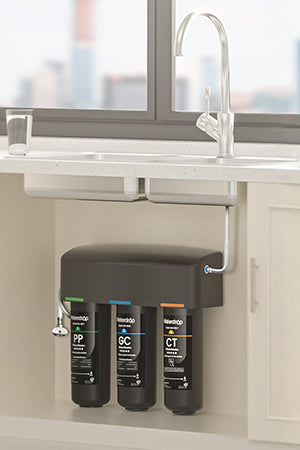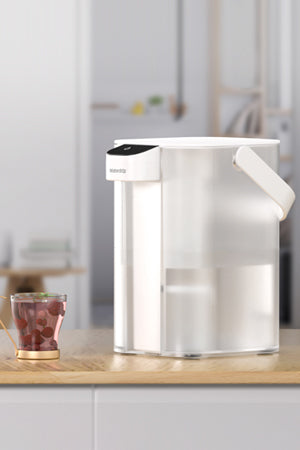Water quality has long been considered an integral part of daily life. However, most of us often disregard the possibility of various contaminants in the water that flows from the tap in our homes.
Per- and polyfluoroalkyl substances , or simply PFAS, constitute one of these contaminants.
These man-made chemicals were found to have become widespread due to being used in manufacturing various items such as non-stick cooking pans, water-resistant fabrics, as well as water-repellent firefighting foams. Although these chemicals work very well as intended, they pose very hazardous long-term health threats.
In this guide, we'll delve into what PFAS are, the worries surrounding them in your drinkable water supplies, and the most effective methods of ridding your water of these pollutants, as residents of Singapore.
PFAS Explained
PFAS chemicals have been commonly referred to as "forever chemicals." The chemicals in question form a category of more than 4,700 man-made chemicals that resist heat, water, and oils.
These chemicals were
first used in the 1940s in the manufacturing of various items such as non-stick pans, stain-resistant fabrics, food packaging, and firefighting foams. The chemical nature of PFAS makes them non-biodegradable. As such, they tend to build up in the environment, organisms, and human tissues.
When these chemicals come into contact with waste disposal or are flushed off from products, they may end up in water resources. Although the purification system in Singapore makes the water from tap sources clean enough to be fit for human consumption, it should be noted that PFAS levels in municipal water sources are rarely checked.
Health Risks of PFAS in Drinking Water
PFAS exposure has been known to trigger various ailments that may end up having long-term impacts on your overall well-being. Although low levels of PFAS in your drinking water may not pose an immediate threat to your health, high exposure levels may result in various serious ailments such as:
-
Cancer: Studies have found that certain PFAS chemicals may raise the chance of cancer occurrence, including kidney cancer and testicular cancer.
-
Liver damage: PFAS can affect liver function , leading to potential liver disease or abnormal liver enzyme levels.
-
Hormone disruption: PFAS have been discovered to affect thyroid hormone creation and can potentially trigger thyroid problems, reproduction-related problems, and various difficulties within the endocrine system.
-
Immune system suppression: PFAS exposure may result in immune system suppression. The immune system may not be able to fight off infections or vaccines.
-
Developmental issues: The pregnant women who come into contact with PFAS may face higher risks of delivering babies who may be born with low birth weight and may also suffer from various developmental delays.
In light of such potential risks, it's important that you take certain measures in order to eliminate or minimize the presence of PFAS in your drinking water.
How to Remove PFAS from Your Water?
Reverse osmosis is considered the most effective technique that can be used to remove PFAS from drinking water. Reverse osmosis involves the use of a semipermeable membrane that filters out the pollutants from water. Reverse osmosis filters can remove as much as 99% of PFAS from water. Reverse osmosis filters have been proven to be very effective when it comes to water purification.
Besides PFAS, reverse osmosis can also eliminate various hazardous components like lead, fluoride, chlorine, and arsenic. The disadvantage of using reverse osmosis, though, is that it also eliminates healthy minerals from the water. Eventually, it can affect both the taste and medicinal value of the water.
How to Choose the Best Product for PFAS Removal in Singapore
If you or your family drink tap water that contains PFAS contaminants, finding an appropriate filtration system – or systems – that work for your particular needs is important. The following list provides a quick checklist to determine the most suitable solution for your particular needs:
For Small Households
For those residing in apartment or homes that do not have enough space, it may be worth considering a
countertop reverse osmosis system . These come handy as they can be placed either in the kitchen or in the living room. Hence, these become ideal for those who do not have enough space at homes or those who rent apartments. Reverse Osmosis has comprehensive filtering capabilities and keeps your water drinkable by eliminating PFAS.
For Larger Households
If your household uses a lot of water, a large volume reverse osmosis system that has higher flow rates may be better suited for your needs. These may include
Waterdrop X Series RO water filters . It ensures that your whole family has clean filtered water.
People Also Ask
What is PFAS exactly?
PFAS stands for per- and polyfluoroalkyl substances. These chemicals have been synthesized by human activity for use in various items such as non-stick cookware, stain-resistant fabrics, and commercial firefighting foam.
The worst part about PFAS is that it poses toxicity as it neither degrades in the environment nor in the human body. The toxicities include cancer and immune system impairment.
How may PFAS affect my personal health?
Prolonged exposure to PFAS may pose numerous health risks to an individual. These include cancer, liver disease, thyroid disease, immunosuppression, and those that affect the development of infants born to women who may be exposed to high levels of PFAS.
How do I remove PFAS from my drinking water?
The best technology for the removal of PFAS from drinking water is reverse osmosis. It works as the most efficient technique by removing around 99% of PFAS. In addition to that, carbon filters may also work on certain types of PFAS.
Conclusion
The problem of PFAS in your drinking water needs to be addressed. Learning more about eliminating PFAS from your water can be important for your health. No matter whether you decide on an RO system, an activated carbon filter, or ion exchange treatment, it may be important to consider which system to use in order to properly get rid of such toxic chemicals.



































































